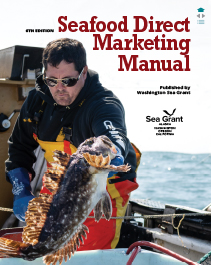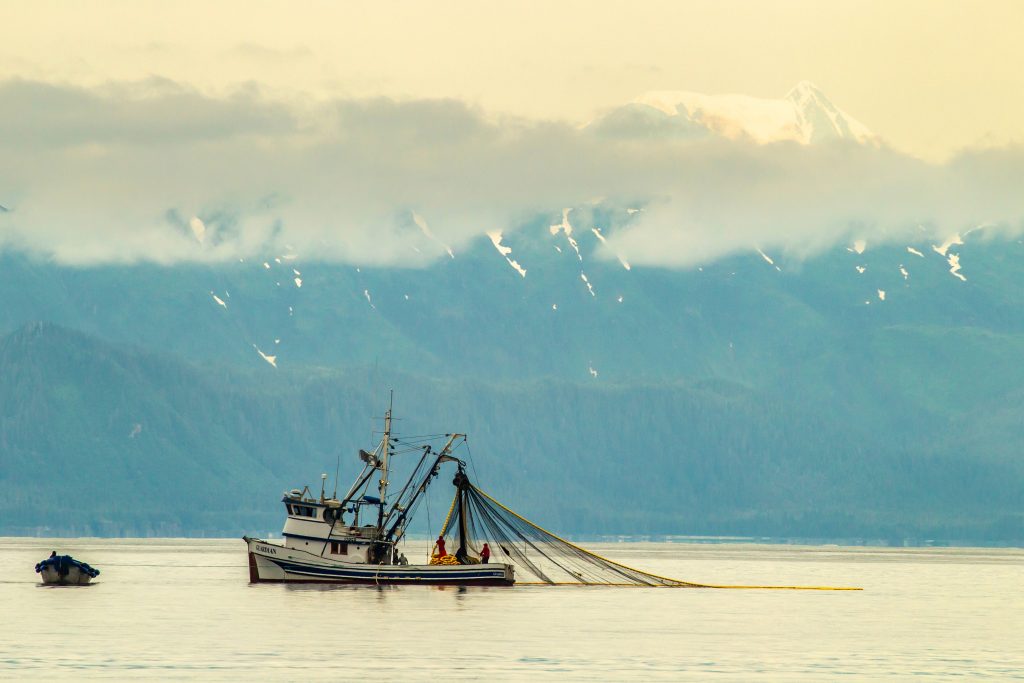The newly revised Seafood Direct Marketing Manual helps seafood harvesters dive into direct-to-consumer sales
From the Summer 2025 Sea Star
By Alison Lorenz, WSG Communications Project Coordinator

The newly revised Sixth Edition Seafood Direct Marketing Manual. Photo courtesy of Oregon Sea Grant.
Starting a business is no easy feat — especially when you throw in the unpredictable nature of boat maintenance, weather, catches and wholesale prices. For many fishermen, selling their product directly to seafood consumers can be a way to regain some control in a notoriously volatile industry. But where does a fisherman who is interested in direct marketing begin?
For more than 20 years, Alaska Sea Grant, in collaboration with other Pacific Coast Sea Grants, has provided the Seafood Direct Marketing Manual (formerly the Fishermen’s Direct Marketing Manual) for just this type of business. The heavily revised sixth edition — a joint effort between Alaska, Washington, Oregon and California Sea Grants — was released this fall, after two years in the making. Covering everything from business planning to ensuring seafood quality to specific state regulations, the Manual is a one-stop shop for fishermen and shellfish growers interested in starting a direct marketing business.
The first edition of the Direct Marketing Manual was published in 1997 as a result of changing economics in Alaskan salmon fisheries. Through the 1990s, new competition from farmed salmon caused salmon prices to drop steeply. More fishermen became interested in starting their own direct marketing operations as a way to cut out middlemen and, in theory, make more money. “There’s a big draw to [direct marketing] when the price is low because it puts a lot more control back to the individual boat,” explains Tav Ammu, a fisherman, Alaska Sea Grant marine advisory program agent, and coauthor of the Manual.
But selling directly to consumers can also mean a lot more work for fishermen, who must determine how to advertise, process, package, and sell their product in addition to catching it. Seeing a growing need, the Alaska Department of Commerce, Community and Development asked Terry Johnson, the late Alaska Sea Grant agent to compile information to help fishermen weigh the pros and cons of getting into direct marketing — and the first Fishermen’s Direct Marketing Manual was born.

These days, salmon prices are low again in Alaska and along the West Coast. New factors have come into play, from the increasing use of social media and online commerce to the COVID-19 pandemic’s impact on supply chains and consumers’ growing desire to be close to their food. Accordingly, alongside evergreen information about accounting and meat chilling, the sixth edition of the Seafood Direct Marketing Manual includes new information about online sales platforms, email marketing, ensuring product quality, fishermen’s and farmers markets, setting up a boat for off-the-boat sales, and much more. The wealth of knowledge comes from a variety of expert contributors from Sea Grant and beyond. Every edition of the Manual has been thoroughly reviewed by fishermen who direct market their products, and fishermen who have used the Manual suggest topics that should be clarified or added. After almost 30 years and the distribution of thousands of copies, the Direct Marketing Manual provides unique value in presenting free, comprehensive information in one place, whether seafood harvesters use the PDF available online or the free printed handbook.
“I like that it is a printed book,” says Sunny Rice, Alaska Sea Grant marine advisory program agent and a coauthor of the Manual. “From an agent’s perspective, when I want to make sure I’m giving someone complete information, the fact that it’s a package is important, rather than just telling someone to Google something.”
The Manual also includes blank pages for notes and hands-on sections like a “strengths, weaknesses, opportunities and threats (SWOT)” analysis to help fishermen determine if direct marketing is right for them. Because, as first edition author Terry Johnson once put it, “It is just as valuable to prevent the wrong person from direct marketing as it is to assist the right person to begin.”
Jenna Keeton, Washington Sea Grant fisheries specialist and the lead editor of the new edition, notes that while the Manual is standalone, it can also serve as an accessory to Alaska Sea Grant’s five-session direct marketing class, or complement Sea Grant’s many other offerings for fishermen. “This is one of many tools that Sea Grant has to help people with their direct marketing operations,” she says. “The Seafood Direct Marketing Manual, [Alaska Sea Grant’s] FishBiz website, in-person conferences, classes — there are lots of opportunities for direct marketers to plug into.”
After all, the ultimate goal of the Manual is to support the West Coast’s small-scale commercial fishing industry. In contrast to large processors who focus on quantity of product, Ammu and Rice note that fishermen interested in direct marketing are often very focused on the quality of the fish they provide. “They want to feel more connected to their customer and have more control over what that fish is like when it gets to the customer,” Ammu says. “They care a lot about the product and what they do, and want to share that directly with the customer.”
“Direct marketers have been a huge piece of delivering high quality fish,” Rice notes. “And they’re often the gateway to people’s experience with seafood.” Seeing fishermen’s passion through a compelling social media post, or having a face-to-face conversation at a dockside market, can be the spark that gets someone interested in purchasing local seafood like crab, oysters and salmon and preparing it at home. “That good experience might increase people’s willingness to purchase it again and seek out seafood in the future,” Rice says.
Fishermen get into direct marketing for many reasons. They may want to explore new markets, take more ownership of their fishing business, supplement their income, or connect more deeply with their customers. They may also decide that direct marketing is not right for them. Whatever their choice, Washington, Alaska, Oregon, and California Sea Grants are here to support them through the Sixth Edition Seafood Direct Marketing Manual and more.
View the Seafood Direct Marketing Manual.
The Seafood Direct Marketing Manual is available for free download.
###
Washington Sea Grant, based at the University of Washington, helps people and marine life thrive through research, technical expertise and education supporting the responsible use and conservation of coastal ecosystems. Washington Sea Grant is one of 34 Sea Grant programs supported by the National Oceanic and Atmospheric Administration in coastal and Great Lakes states that encourage the wise stewardship of our marine resources through research, education, outreach and technology transfer.
Join the conversation: instagram.com/waseagrant and Facebook.com/WaSeaGrant.
FEB
2025